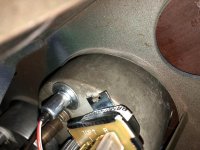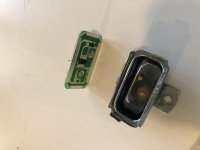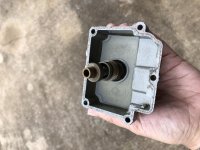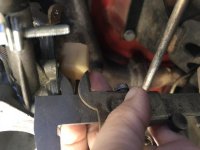dklawson
Yoda
Offline
If I am reading your post correctly, the engine will idle fine but when you remove the damper from the top of the rear carb (not doing anything else) the engine wants to die. Is that correct?
If you unscrew the damper slowly and remove it slowly does this happen? Do you have oil in one carb and not the other? During installation of the new diaphragm did you make sure both its tabs were in the corresponding slots of the piston and carb body? Unless there is a good sized air leak, if you were running molasses instead of oil in the dashpot, I cannot see why removing the damper should cause the engine to die.
Those test wires are inserted and removed with the engine "off", NOT with the engine running. The height of those wires indicates how high the piston is in each carb. When the wire tips are at the same level the carbs are sucking equal amounts of air. You insert and align the wire tips to each other with the engine off the air pistons are resting on the bridge of their carb. That is the baseline... both carbs sucking Zero air, both pistons on their carb's bridge, wire tips pointing at each other. Once the wires are inserted and aligned do not touch or bump them again until the carbs are balanced. Start the engine and notice where the wire tips are relative to each other. Use the idle screws on both carbs as necessary to change how much air each carb is pulling. You will notice when you turn a carb's idle screw speed screw in, the carb piston (and pointing wire) go "up". Tweak either/both of the idle speed screws until the wire tips point at each other again with the engine running. Once they are pointing at each other, tighten the linkage screws and adjust the idle screws equal amounts to get the idle speed you want.
If you unscrew the damper slowly and remove it slowly does this happen? Do you have oil in one carb and not the other? During installation of the new diaphragm did you make sure both its tabs were in the corresponding slots of the piston and carb body? Unless there is a good sized air leak, if you were running molasses instead of oil in the dashpot, I cannot see why removing the damper should cause the engine to die.
Those test wires are inserted and removed with the engine "off", NOT with the engine running. The height of those wires indicates how high the piston is in each carb. When the wire tips are at the same level the carbs are sucking equal amounts of air. You insert and align the wire tips to each other with the engine off the air pistons are resting on the bridge of their carb. That is the baseline... both carbs sucking Zero air, both pistons on their carb's bridge, wire tips pointing at each other. Once the wires are inserted and aligned do not touch or bump them again until the carbs are balanced. Start the engine and notice where the wire tips are relative to each other. Use the idle screws on both carbs as necessary to change how much air each carb is pulling. You will notice when you turn a carb's idle screw speed screw in, the carb piston (and pointing wire) go "up". Tweak either/both of the idle speed screws until the wire tips point at each other again with the engine running. Once they are pointing at each other, tighten the linkage screws and adjust the idle screws equal amounts to get the idle speed you want.

 Hi Guest!
Hi Guest!

 smilie in place of the real @
smilie in place of the real @
 Pretty Please - add it to our Events forum(s) and add to the calendar! >>
Pretty Please - add it to our Events forum(s) and add to the calendar! >> 



